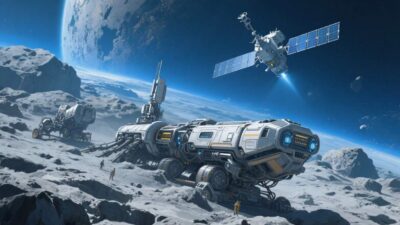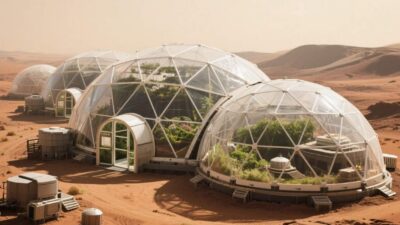The Exoplanet Era and the Promise of Terraforming
The past three decades have revolutionized our understanding of the cosmos. Missions like NASA’s Kepler and TESS have discovered over 5,000 exoplanets, with thousands more candidates awaiting confirmation. Among these, a growing subset—termed “potentially habitable”—orbits within their star’s “Goldilocks zone,” where liquid water could exist. This has ignited humanity’s ambition to explore, settle, and even terraform these distant worlds.
Terraforming—modifying a planet’s environment to support Earth-like life—is no longer confined to science fiction. However, the complexity of altering a planet’s atmosphere, climate, and geology demands unprecedented precision. Enter AI-driven terraforming simulations: cutting-edge tools that use machine learning (ML), neural networks, and computational modeling to predict, optimize, and mitigate the risks of transforming exoplanetary environments. This report explores how AI is reshaping our ability to turn distant worlds into viable homes, addressing technical, ethical, and logistical challenges along the way.
What Are AI-Driven Terraforming Simulations?
AI-driven terraforming simulations are computational models that leverage artificial intelligence to predict the outcomes of altering an exoplanet’s environment. These simulations integrate data from planetary science, climate modeling, and astrophysics to:
- Predict Environmental Responses: Forecast how introducing greenhouse gases, modifying atmospheric composition, or altering surface albedo (reflectivity) will affect temperature, pressure, and habitability.
- Optimize Terraforming Strategies: Test thousands of hypothetical scenarios (e.g., “What if we deploy 1,000 CO₂ factories on Mars?”) to identify the most efficient and low-risk methods.
- Assess Risks: Simulate unintended consequences, such as runaway greenhouse effects, disruption of subsurface ecosystems, or chemical contamination of water sources.
At their core, these simulations merge data-driven AI (trained on observational data from telescopes, lab experiments, and historical planetary missions) with physics-based models (e.g., computational fluid dynamics for atmospheric circulation or thermodynamics for heat transfer).
Key Applications of AI-Driven Simulations in Exoplanet Terraforming
1. Candidate Selection: Identifying the Most Promising Exoplanets
With over 5,000 exoplanets discovered, narrowing the field to viable candidates is critical. AI analyzes exoplanet data—including atmospheric composition (from spectroscopy), orbital parameters, and stellar radiation—to rank planets by “terraformability.” For example:
- Atmospheric Analysis: AI models trained on Earth’s atmospheric evolution predict which exoplanets have the right mix of gases (e.g., CO₂, O₂, N₂) to stabilize a habitable climate.
- Surface Conditions: Machine learning algorithms evaluate surface features (e.g., presence of liquid water, geological activity) to assess readiness for human habitation.
NASA’s Exoplanet Terraforming Potential Index (ETPI), a prototype AI tool, uses such metrics to flag planets like Trappist-1e (a rocky, Earth-sized world in the habitable zone) as top candidates.
2. Designing Terraforming Strategies: From Greenhouse Gases to Magnetic Fields
Terraforming requires precise interventions. AI simulates diverse strategies to identify the most effective:
- Greenhouse Gas Injection: Models predict how releasing CO₂ from polar ice caps (as proposed for Mars) or importing volatile compounds (e.g., methane from comets) would raise surface temperatures.
- Atmospheric Thickening: Simulations test methods to thicken thin atmospheres (e.g., on Mars) using aerostats, orbital mirrors, or chemical reactions.
- Magnetic Field Creation: AI evaluates the feasibility of generating artificial magnetospheres (via underground superconducting coils or orbital magnets) to protect atmospheres from stellar winds.
For instance, a 2023 study by MIT’s Climate and Terraforming Lab used AI to simulate converting Venus’s runaway greenhouse atmosphere into a breathable one. The model proposed a phased approach: first cooling the planet with reflective aerosols, then introducing oxygen-producing microbes.
3. Risk Mitigation: Predicting Unintended Consequences
Terraforming is not without risks. AI simulations highlight potential pitfalls:
- Runaway Effects: Over-injection of greenhouse gases could lead to extreme warming, as seen in Venus’s 460°C surface. AI models quantify these thresholds.
- Ecological Disruption: If an exoplanet hosts microbial life, altering its atmosphere could annihilate or mutate these organisms. Simulations help assess such impacts.
- Resource Depletion: Extracting resources (e.g., water ice from asteroids) for terraforming may strain interplanetary supply chains. AI optimizes resource allocation to minimize waste.
A 2022 project by the European Space Agency (ESA) used AI to simulate the risks of terraforming Mars, concluding that gradual CO₂ release (over 1,000 years) would avoid catastrophic temperature spikes.
4. Resource Optimization: Maximizing Efficiency
Terraforming is energy-intensive. AI optimizes resource use by:
- Predictive Maintenance: Machine learning models forecast equipment failures (e.g., CO₂ scrubbers, orbital mirrors) to minimize downtime.
- Energy Sourcing: Simulations compare the efficiency of solar, nuclear, or fusion power for terraforming operations, prioritizing low-energy methods.
For example, AI-driven models for Terraforming Mars (a proposed mission) determined that using orbital solar farms (powered by Mars’s 24.6-hour day) would reduce energy costs by 30% compared to nuclear reactors.
Technological Foundations: The AI Toolkit for Terraforming
AI-driven terraforming simulations rely on a suite of advanced technologies:
1. Machine Learning (ML) and Deep Learning (DL)
- Neural Networks: Trained on datasets of Earth’s climate history, exoplanet spectra, and lab experiments, these models learn to predict atmospheric behavior. For example, a convolutional neural network (CNN) analyzes spectroscopic data to identify atmospheric gases.
- Reinforcement Learning (RL): AI agents “learn” optimal terraforming strategies by simulating thousands of scenarios and receiving feedback (e.g., “raising temperature by 5°C reduces habitability risk by 20%”).
2. Computational Fluid Dynamics (CFD) and Physics Engines
AI integrates CFD to simulate atmospheric circulation, heat transfer, and chemical reactions. Tools like OpenFOAM (open-source CFD software) are enhanced with ML to predict turbulence in exoplanet atmospheres.
3. Data Integration: From Telescopes to Labs
Simulations draw on:
- Telescopic Observations: Data from instruments like the James Webb Space Telescope (JWST) (which analyzes exoplanet atmospheres via spectroscopy).
- Laboratory Experiments: Results from experiments simulating extraterrestrial conditions (e.g., Mars-like soil in NASA’s Atacama Desert tests).
- Historical Missions: Data from Mars rovers (e.g., Perseverance) and Venus probes (e.g., Venera) to calibrate models.
Case Studies: AI in Action for Exoplanet Terraforming
1. NASA’s Mars Terraforming Initiative
NASA’s Mars Terraforming Program uses AI to simulate converting Mars’s thin, CO₂-rich atmosphere into a breathable one. Key simulations include:
- Atmospheric Thickening: AI models predict that releasing 10^16 kg of CO₂ (stored in polar ice caps and regolith) over 100 years would raise surface pressure to 0.5 atm (Earth’s is 1 atm).
- Oxygen Production: Machine learning optimizes microbial colonies (e.g., Synechococcus cyanobacteria) to produce O₂, with simulations showing a 10% O₂ concentration could be achieved in 500 years.
2. ESA’s Venus Cloud City Concept
ESA’s High Altitude Venus Operational Concept (HAVOC) proposes floating cities in Venus’s upper atmosphere (50–60 km altitude), where temperatures (20–30°C) and pressures (0.5–1 atm) are Earth-like. AI simulations model:
- Cloud Stability: Predicting how solar-powered aircraft could maintain altitude amid Venus’s violent winds.
- Life Support: Optimizing closed-loop systems to recycle air and water, with AI reducing energy consumption by 25%.
3. The Terraforming Mars Project (Elon Musk’s Vision)
While speculative, Elon Musk’s proposed Mars colonization effort relies on AI to simulate terraforming steps, such as:
- Nuclear Bombing of Polar Caps: AI models assess the feasibility of using nuclear explosions to release CO₂ and water vapor.
- Importing Water: Simulations test the logistics of redirecting comets to Mars, calculating the energy required to alter their trajectories.
Challenges and Limitations
Despite progress, AI-driven terraforming simulations face significant hurdles:
1. Technical Complexity
- Non-Linear Systems: Planetary atmospheres, geologies, and climates are chaotic, with countless variables interacting. AI models struggle to capture this complexity, leading to unpredictable outcomes.
- Data Gaps: Exoplanet data is limited (e.g., only 10% of known exoplanets have measured atmospheres). Incomplete data reduces model accuracy.
2. Ethical and Philosophical Concerns
- Planetary Protection: Altering an exoplanet’s environment could destroy indigenous life (if any). The Outer Space Treaty (1967) prohibits contamination, but AI simulations must weigh “benefit to humanity” against “preservation of alien ecosystems.”
- Resource Allocation: Terraforming requires trillions of dollars and global collaboration. AI must address equity—ensuring benefits are shared, not hoarded by wealthy nations.
3. Logistical and Temporal Barriers
- Time Scales: Terraforming a planet could take centuries (e.g., Mars’s atmosphere would take 1,000+ years to thicken). AI must model long-term stability, not just short-term gains.
- Energy Requirements: Scaling terraforming to exoplanets demands fusion or advanced nuclear power, technologies still in development.
The Future: AI as a Catalyst for Interstellar Colonization
The future of AI-driven terraforming simulations lies in innovation and collaboration:
- Advanced AI Models: Next-gen neural networks (e.g., transformer models) will process vast datasets, improving predictions of planetary behavior.
- Quantum Computing: Quantum simulators could model complex quantum interactions in exoplanet atmospheres, unlocking new terraforming strategies.
- Global Governance: International frameworks (e.g., the United Nations Office for Outer Space Affairs) will regulate terraforming, ensuring ethical and equitable practices.
- Public Engagement: AI-driven visualizations (e.g., VR simulations of terraformed exoplanets) will educate and inspire global support for these endeavors.
Terraforming the Future, One Simulation at a Time
AI-driven terraforming simulations are not just tools—they are bridges between humanity’s ambition and the cosmos. By predicting outcomes, optimizing strategies, and mitigating risks, these simulations turn the dream of exoplanet habitation into a tangible reality. As technology advances and our understanding of planetary systems deepens, AI will play an increasingly critical role in making distant worlds not just habitable, but thriving homes for future generations.
The journey to terraform exoplanets is just beginning. With AI as our guide, we are one step closer to writing the next chapter of human exploration—one simulated atmosphere at a time.



